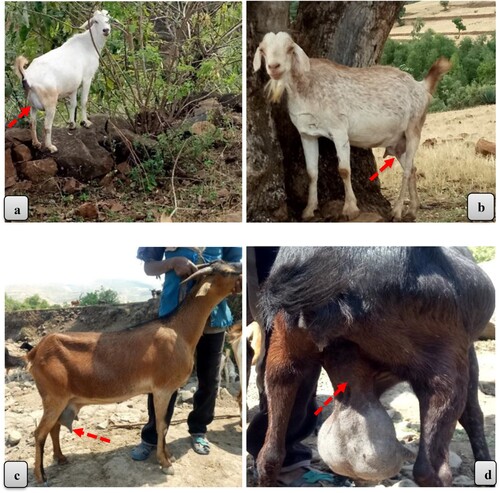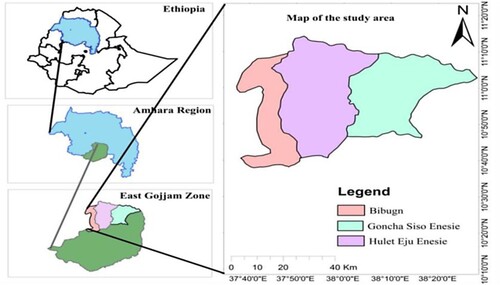Figures & data
Table 1. Summary of the total number of sample goats and PAs by districts
Table 2. Definition of conformation traits used in the study.
Figure 2. Structural qualitative conformation traits of a doe and a buck in the study area (Photo courtesy: Mezgebu Getaneh). A strong loin, straight rear legs as viewed from the side and rear, and normal rump angle doe (a); a buck with intermediate rump angle and loin strength, and strait rear legs as viewed from the side and rear (b); LS = Loin strength; RLSSV = Rear legs set side view.

Figure 3. Different types of does’ udder and teat morphology in East Gojjam Zone (Photo courtesy: Mezgebu Getaneh). A well attached udder to the body wall and have a strong central ligament/cleft as viewed from the rear (a) and as viewed from the front (c); finger-like teats pointing downward (c), udder intermediately attached to the body wall as viewed from the front with teats pointing to the front as viewed from the side (b), loosely attached udder as viewed from both front and rear, have broken central ligament, hanging below the hocks and have tiny teats pointing to the front as viewed from the side (d).

Table 3. Descriptions of qualitative conformation traits of does in East Gojjam Zone.
Table 4. Descriptions of qualitative conformation traits of does and bucks in East Gojjam Zone.
Table 5. Mean (±SD) of body weight (kg) and conformation traits measurements (cm) of local does in East Gojjam Zone.
Table 6. Mean (±SD) of udder and teat measurements (cm) of local does in east Gojjam Zone.
Table 7. Mean (±SD) of body weight (kg) and conformation traits measurements (cm) of local bucks in East Gojjam Zone.
Table 8. Pearson's correlation coefficients between structural conformation traits of local does in East Gojjam Zone.
Table 9. Pearson's correlation coefficients between structural conformation traits of local bucks in East Gojjam Zone.
Table 10. Regression of live body weight on different body measurements for local does and bucks in East Gojjam Zone.

